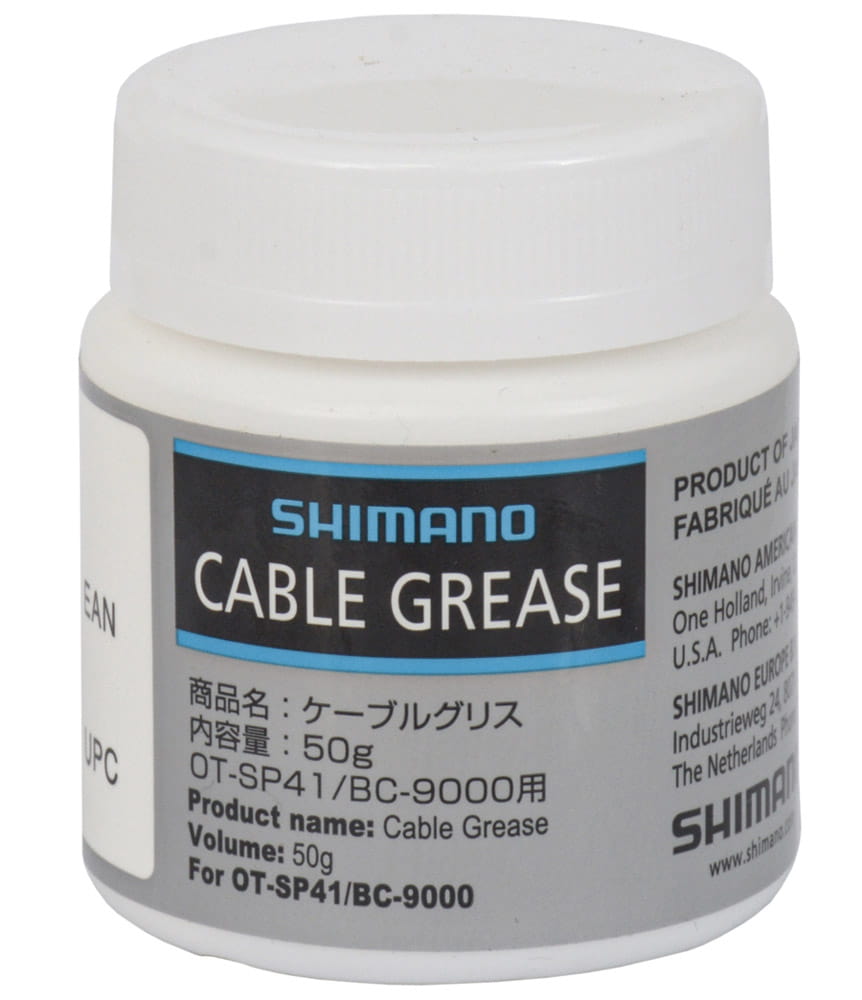Technical specifications and recommended use case for the Shimano cable grease.
I already wrote about:
– Should you lubricate cables and housing?
– Greases explained in great detail.
1. What it’s good for and the exact model?
Special cable grease for OT-SP41 housing and BC-9000 & BC-R680 cables.
Better than typical greases for long-term cable smoothness. In other words: based on my and other mechanics’ experience, it doesn’t get gummed up after a year in the housing like other greases and oils.
My shimano housing 2-year experiment/test video
Shimano’s website is rubbish (and breaks links even when they’ve worked for a while), so I can only find and share webshop links for the product:
- Shimano Special Grease for OT-SP41/BC-9000 Outer Cable 50g
German Bike-discount website link - MAST SHIMANO CABLE 50g
Serbian Planet Bike website link.
According to Shimano, this is: “Special grease for OT-SP41, BC-9000 and BC-R680 outer cables.”
- Manufacturer item no: Y0418000A
- EAN: 4550170875565
- UPC: 192790875569
2. Technical specifications
Reiterating the model and officail specs for a start:
According to Shimano: “Special grease for OT-SP41, BC-9000 and BC-R680 outer cables.”
- Manufacturer item no: Y0418000A
- EAN: 4550170875565
- UPC: 192790875569
2.1. Properties discussed
It is very soft (NLGI hardness: NLGI 0 or NLGI 00), almost like liquid, but not quite.
It is a good quality silicone grease (note that the link discusses the use for bicycle bearings, not cable lubrication).
2.2. Ingredients discussed
Ingredients, based on the below-referenced Shimano specs:
- Base oil:
Synthetic silicone based oil - Thickener:
Lithium soap thickener - Additive:
Poly tetra fluoro ethylene, also known as PTFE or “Teflon”
| Ingredient / purpose | Deeper Explanation |
|---|---|
| Synthetic Silicone Oil / Main slipperiness and stability provider | – Extremely low surface tension → reduces friction better than mineral or synthetic hydrocarbons. – Does not evaporate easily → remains stable for years. – Temperature resistant → stays viscous across -50 °C to +200 °C or more. – Chemically inert → doesn’t react or break down easily. – Doesn’t gum up → because silicone oils resist oxidation and polymerisation (main causes of gumming in mineral oils). |
| Lithium Soap Thickener / Keeps the oil suspended, and gives the grease its semi-solid texture | – Turns the oil into a grease (semi-solid). – Holds oil in place inside the cable housing. – Helps the grease stay put instead of running out. – Lithium soaps are stable, water-resistant, and work well with silicone oils. |
| PTFE (Polytetrafluoroethylene) / Further reduces friction | – Micro-particles of Teflon-like material. – Provide solid lubrication even if some oil is displaced. – Reduces static friction and dynamic friction (reduces stick-slip and cable drag), so is good for tiny, high-pressure points like inside cable strands. – PTFE keeps things moving smoothly even when the grease starts drying slightly. |
Conclusion
Based on my theoretical knowledge and practical experience with lubricants, it makes sense for this grease to work as it does. The listed ingredients have properties that enable such performance.
Despite that, I could not find a cheaper, more general purpose grease (or oil) that does a similarly good job. So, unlike bearing greses and other uses, this is one of the cases where I pay the premium “Shimano tax” for getting the job done.
References
- Shimano website document:
https://si.shimano.com/pdfs/compliance/sds/cable%20grease-202008-ENG-GHS.pdf - Bike-Discount shopping link (under $20 for 50g):
https://www.bike-discount.de/en/shimano-special-grease-for-ot-sp41/bc-9000-outer-cable-50g - Bicycle shifter, brake cable, and housing standards:
https://bike.bikegremlin.com/8548/cable-housing-standards/ - Bicycle bearing greases – explained:
https://bike.bikegremlin.com/1985/bicycle-bearing-grease-explained/
Last updated:
Originally published:

